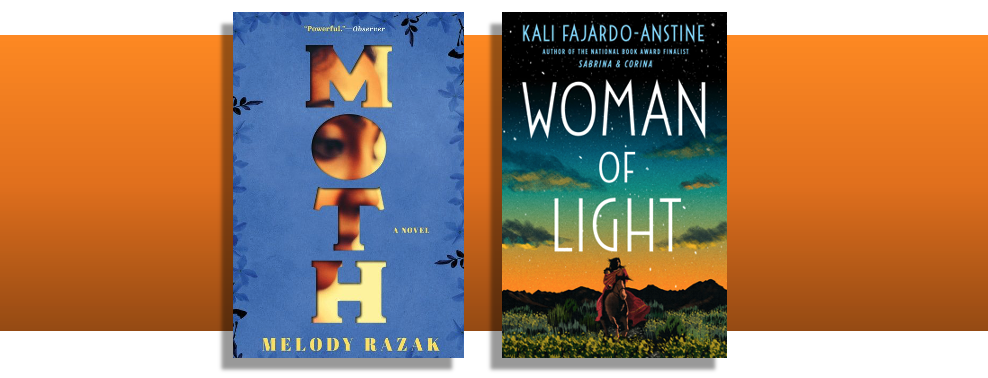Moth: A Novel by Melody Razak (Harper, 2022) and Woman of Light: A Novel by Kali Fajardo-Anstine (One World, 2022) are two books I recently read. Both have well-developed characters and plots that kept me engaged and wanting to find out what happens. Both are about different cultures, so that with both books came the satisfaction of learning.
Moth takes place in India right before and after India’s independence from Britain at midnight on August 15, 1947. Previously I had read Freedom at Midnight, a non-fiction account of this period that portrayed the creation of two countries: Muslim Pakistan and Hindu India. About 15 million people were forced to leave their homes to move to the other country of their religion, and about one million were killed by extreme people of the two religions.
Moth is about one Hindu Brahmin (high caste) family living in Delhi, in northern India. The novel shows the terror and brutality of the time, including violence against women, which we sometimes read continues in both countries. But while this violence is the environment for the novel, the reactions of the family members, which reveal their characters, dominate the story.
Ultimately this became Alma’s story, written so that I wanted to accompany her journey.”
Two daughters, Alma (14) and Roop (12), of the Brahmin family are the heroes. Before the division in 1947, the parents are highly functioning, and the children’s lives are as we might expect for Indian children. But the parents are unable to respond to the violence and terror that follow the division. Meanwhile, the two girls are forced to respond for them and their family to survive. I cared for these fictional characters, and understood the parents’ paralysis in the midst of the terror, but I became exasperated at the their inability to look out for themselves or their children. Ultimately this became Alma’s story, written so that I wanted to accompany her journey.
Fajardo-Anstine’s Woman of Light is about a mixed Mexican/Native American family in segregated Denver in the 1930s, and the family’s ancestors in the “Lost Territory” west of Denver in the late 19th/early 20th centuries. Seventeen-year-old Luz is the Denver story’s protagonist where she lives with her aunt, Maria Josie, and her brother, Diego. The Anglos, often robed as Ku Klux Klan members, beat Diego and force him to leave town for having a relationship with and impregnating a young white woman. Earlier in the Lost Territory, radium miners murdered Luz’s grandfather, Pidri, and grandmother, Simodecea, in order to steal their property. This crime is an earlier version of the kind of violence and discrimination against Luz and her family in the Denver story.
In part this is a coming-of-age story with Luz learning about life and earning money to help support the family. She works as the assistant to a Greek attorney who is fighting an uphill battle to force a grand jury to consider the murder by a policeman of a Latinx man. The attorney’s initial success causes the Klan to turn their violence onto the attorney, also threatening Luz.
I believe that Fajardo-Anstine does an outstanding job of showing how Luz begins to develop, sometimes falls back, and then recovers to further develop.”
The story shows the difficult lives this minority family endures as they struggle to make a living, always in fear of mistreatment, including violence from the Anglos. We often read history intellectually but without feeling and understanding the effects of the history. However, Woman of Light shows (as does Moth, and as a good novel must) the challenges for the characters and the effect of those challenges on their selves and their lives.
Spoiler alert: I’m about to write about the novel’s ending to show how skillfully it is written. Like many 17-year-olds, Luz stumbles through her 18th year, making some questionable decisions, uncertain where her life is headed. In a novel that emphasizes character, we expect the main character to develop like Scrooge in A Christmas Carol, or to disintegrate like Gatsby in The Great Gatsby. When a character is 17-turning-18, like Luz, reality limits the extent we expect a character to develop toward maturity, to make the best decisions, to decide where her life is headed. I believe that Fajardo-Anstine does an outstanding job of showing how Luz begins to develop, sometimes falls back, and then recovers to further develop. Just what we would expect from a young woman her age.
When I read a novel, I hope the novel’s conflicts will be resolved favorably for the protagonist I’ve grown to care about. In other words, I want a good ending. Luz and her family’s conflicts do not end well, so I was initially disappointed with the ending. But then I realized that the theme of Woman of Light is that life was often impossible for non-white, Denver citizens in the 1930s. So why should all conflicts resolve well for Luz and her family? Meanwhile Diego does return to Denver, where he claims from an orphanage the child from his earlier relationship. The family may not have all that they (and I) hoped for, but they do have an intact family in which they care for each other and move on in life. Fajardo-Anstine has written a good ending consistent with the theme of the novel.
